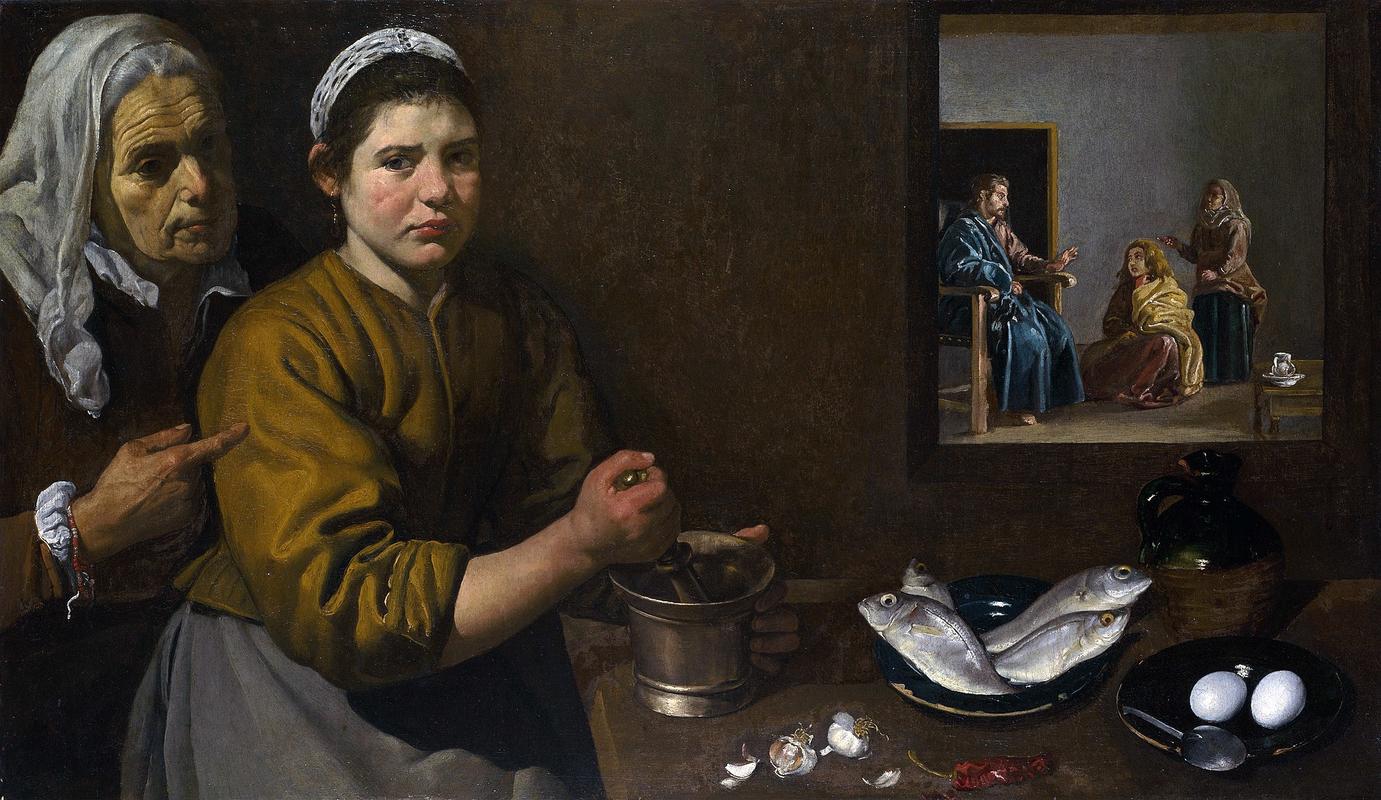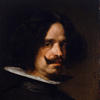More about Kitchen Scene with Christ in the House of Martha and Mary

Contributor
Nobody seems to be able to figure out the true meaning behind Diego Velázquez’s Christ in the House of Martha and Mary.
This painting is an essential part of Velázquez’s early works. In fact, he was only nineteen years old when he painted it, long before he became the court painter to the Spanish King, and before he painted the famous Las Meninas. Regardless of his young age, this work, along with Old Woman Cooking Eggs painted the same year, is executed masterfully. Velázquez was actually one of the first Spanish painters to ever dabble into the ‘bodegón’ genre, which essentially represented everyday scenes taking place in kitchens or taverns (‘bodegas’ in Spanish), with a prominent still-life element.
Flemish painters had already experimented with a similar genre, and it’s possible that young Velázquez was inspired by them. The incredible realism with which the figures are painted in this picture, as well as the marked contrast between light and dark, is perhaps also inspired by Caravaggio, whose prints circulated in Spain at the time. However, Velázquez put his own unique spin on it. Inside this kitchen setting, he put a picture of a Biblical scene, in particular, Christ visiting the house of Martha and Mary. Inserting this scene into another painting is a signature Velázquez move. The sort of ‘painting-within-a-painting’ adds a whole new level of meaning to the main kitchen scene.
In this case, the 'painting' had scholars debating for years. They can’t seem to agree on whether Christ's scene is actually just a painting on the wall, if it’s a mirror reflection of the other side of the room, where the scene takes place, or if it’s a window to another room. I know, what’s the big deal? It’s just a small part of the picture, anyway! The truth is, how we interpret this religious scene changes the meaning of the whole artwork.
The usual interpretation of this Biblical story is that Mary, the one sitting by Christ’s feet and listening to his preachings, is doing the right thing — focusing on her spirituality. While her sister Martha only cares about preparing food and lodgings for Christ instead of enriching her soul with Christ’s teachings. If this picture is indeed a window to the next room or a mirror reflection, the scene would be unfolding directly in the presence of the two women, teaching them a lesson on the importance of devotion. This, however, is a bit odd, since the women are wearing contemporary 17th-century clothing, suggesting that the two events couldn’t happen at the same time.
On the other hand, if it’s simply a religious painting on the wall, which was a frequent sight in the interiors of homes and taverns, Velázquez uses it to teach us a moral lesson. The old woman gesturing to the painting is a reminder to the younger girl that she should not complain about having to do physical labor (like Martha), and should also focus on her spirituality, which is ultimately more important. But, and this is crucial, it is also super likely that Velázquez took a different turn here — instead of praising the passive, spiritual life of the young woman, he praises her active life, her hard labor — which is obvious from her pained expression, flushed cheeks and red fingers. After all, she is literally the biggest figure in the painting, and she’s the only figure looking out at us, making us understand that she is important.
This interpretation makes a lot of sense if we consider the fact that the Counter-Reformation was full-blown at the time in all Catholic countries, Spain included. The idea of Counter-Reformation was to show the followers of the Church, through art, that leading an active, righteous, and hard-working life is much more important than simply focusing on spirituality on a purely intellectual level – an ideal preached by the Protestant Church. This is also why Baroque art, of which Velázquez was the greatest Spanish representative, was so proliferated with religious themes.
Ultimately, though, Velázquez might have simply painted this work to practice still-life painting, an element that actually takes up a large chunk of the composition.
Sources
- Carr, Dawson W. et al. Velázquez. London: National Gallery, 2006.
- Earls, Irene. Baroque Art: A Topical Dictionary. Greenwood Press, 1996.
- Tiffany, Tanya J. “Visualizing Devotion in Early Modern Seville: Velázquez’s ‘Christ in the House of Martha and Mary.’” in The Sixteenth Century Journal 36, no. 2, 2005. URL = https://doi.org/10.2307/20477363.
Featured Content
Here is what Wikipedia says about Christ in the House of Martha and Mary (Velázquez)
Christ in the House of Martha and Mary is an oil-on-canvas painting by the Spanish artist Diego Velázquez, dating to his Seville period, now in the National Gallery, London. It was probably painted in 1618 (it is dated, but the "8" is "fragmentary" and uncertain), shortly after he completed his apprenticeship with Pacheco. At this time, Velázquez was experimenting with the potential of the bodegones, a form of genre painting set in taverns (the meaning of bodegon) or kitchens which was frequently used to relate scenes of contemporary Spain to themes and stories from the Bible. Often they contained depictions of people working with food and drink.
Check out the full Wikipedia article about Christ in the House of Martha and Mary (Velázquez)












